Covid-19 has changed the face of the whole world - everything we do, from communicating to our loved ones and buying things to even doing our jobs! A pulse oximeter is a simple device that acts as a blood oxygen meter and is used to gauge if you have normal blood oxygen level in your body or not. Especially in use during the Covid-19 pandemic, oximeters are small, non-invasive devices that are attached to a person’s fingertip. This device indicates the oxygen level present in the body by reading the pulse. Having a stable, normal oxygen level in Covid is extremely important.
The oxygen level in your bloodstream is displayed on the screen along with the pulse rate. This is especially useful for keeping track of the healing progress of patients who have illnesses related to a respiratory disorder. A blood oxygen meter is used in the diagnosis of a number of illnesses related to the respiratory and other similar disorders.
In this article, we will take a look at how a pulse oximeter works, how it can be used at home for keeping a track of Covid-19 and which are some of the best pulse oxymeters out there.
The role of pulse oximeters
Although unable to detect Covid infection itself, a pulse oximeter plays an extremely helpful role in detecting the severity of the infection, especially to detect the chance of ‘Covid pneumonia’. Often, patients never realize that their lungs are affected and that they don’t have normal oxygen level at all. But that is not all - even if you have been diagnosed with Covid-19 and have been admitted and discharged from the hospital, it is crucial to keep track of how your oxygen levels are progressing.
A pulse oximeter can detect the drop in normal oxygen level in the blood, notifying the medical professional of a potentially dangerous issue. This has helped numerous Covid patients in their recovery and has prevented them from getting to a very serious stage of infection. A pulse oximeter is also useful for people who are living with the person who has been diagnosed with Covid-19.
They may not show any symptoms, but oxygen levels may be dropping in the background, without anyone noticing. A pulse oximeter can be a great tool help to detect such potential threats to health.
It is important to note that there are many health conditions even apart from a Covid infection that can cause a drop in blood-oxygen levels. This is why a pulse oximeter reading is not used as a Covid test on its own, but as a sort of medical compass to detect the unmanifested severity of the condition, as well as to keep track of the patient’s improvement.
Always remember, the unmanifest damage could lead to severe after-effects - and we are living at a time when whatever little damage that can be prevented, should be.
How do pulse oximeters measure oxygen levels?
There is a simple answer, a little more complicated answer, and a full-blown scientific answer. For the sake of keeping things as simple but accurate as possible, let’s stick to seeing the first two kinds of answers.
When a pulse oximeter is attached to your fingertip (which is also why it can also be called a finger oxygen sensor), one side beams a ray of light to the other side. The other side reads the light that it is receiving after it has passed through your finger (fingertips are usually chosen because the skin membrane has to be especially thin so that the beam of light should easily pass through the bloodstream). Depending on how the beam hits the other side, the pulse oximeter is able to assess the oxygen levels in the blood.
A slightly more technical answer would be that the pulse oximeter beams red and infrared light wavelengths through the skin and bloodstream. The other side makes an assessment based on how much light is absorbed by the bloodstream. You would already be aware that arterial blood is red in color due to the oxygenated hemoglobin it contains.
Oxygenated hemoglobin absorbs infrared light while hemoglobin absorbs red light. The receiving end makes an assessment of the quality of light it is receiving, which tells it how much of oxygenated hemoglobin is present in the blood. A normal blood oxygen level would be anything between 75 and 100 mm HG.
Needless to say, if the patient is having a lack of oxygen, then the amount of oxygenated hemoglobin in the bloodstream is less, which means lesser absorption of light. The pulse oximeter then, with the use of some complex permutations and combinations, will present its findings.
Can a pulse oximeter be a helpful tool for monitoring Covid-19 at home?
Yes. The days when it was enough to have sanitizers, masks, disinfectants, etc. at home are long gone. With each mutation, the virus is becoming more dangerous. As such a pulse oximeter has become an important tool to have at home. If you have not gotten one yet, you should seriously consider buying for home, even if you or anyone at home haven’t been diagnosed with Covid-19.
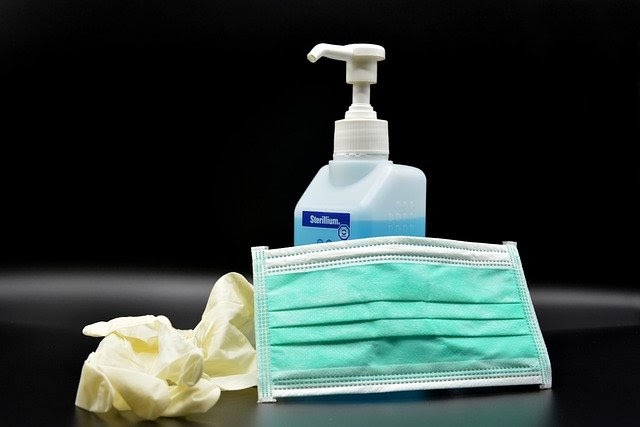
While a pulse oximeter will not detect Covid itself, it can still be a useful tool for monitoring the presence or progress of any unseen complications - especially in those individuals who are asymptomatic. If you thought that being asymptomatic is a safe state to be in, then you should know that damage can still be happening in secret, and will be seen outside only when it is very late.
That is why, a pulse oximeter can be of great hel - any drop in oxygen will be detected at an early stage so that you can get the right kind of medical attention in the nick of time. Do not underestimate the benefits of having an early detection - this will not only save you a lot of expenditure and cost, but also save you from the future complications that could arise from a Covid-19 infection. Also, do not forget that the pandemic hits in waves - and if you find out that you are at an advanced stage of infection in the thick of a wave, you may have to face a lack of hospital beds, scarcity of medications, and poor medical attention.
Besides, a pulse oximeter is also helpful to track the progress that Covid patients are making, even after they have been discharged. For instance, if you have been discharged from the hospital, you may still have to constantly keep track of your oxygen levels so that your doctor can be sure that you are on the track to recovery.
Chances of mistaken discharges or relapses cannot be ruled out. One of the worst things to happen is if you are discharged from the hospital, but the infection is still causing damage within. If it is, then it would be advisable to seek medical help again.
By now, you would have understood how important it is to have a pulse oximeter at home. Now let us take a look at some pulse oximeters and you can decide which is the best pulse oximeter for you.
Top 9 Best Oximeters to Buy In 2021
Well, obviously all pulse oximeters do basically the same thing. But we are human - we would still want to buy only the best. These 9 are options we have curated for you so you can pick the best pulse oximeter for your needs.
Most of the options we have listed here easy to use, which can be a huge relief for users. Especially during the pandemic, people are worried and in panic mode and may not have the patience or time to understand the nitty-gritties of how devices work. The more something can be made simple and easy to handle, the better.
Table of Contents
1. Oxiline Pulse
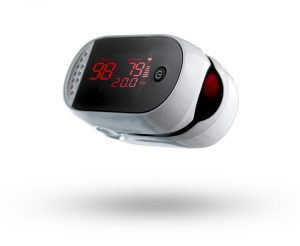
The very first thing that you will notice the product telling about itself is that it gives you accurate pulse oximeter readings in under 7 seconds - and we all know how important each second is in the current scenario. Besides, it has some amazing features such as letting you know your PI index, which can be helpful to know if you are taking the test properly or not, large digits against a crisp contrast so that you can find it easy to read no matter what your circumstances, and a battery life of about 6 months!
This super-light oxygen level reader comes with an FDA clearance and is perhaps the best pulse oximeter out there.
2. Beurer
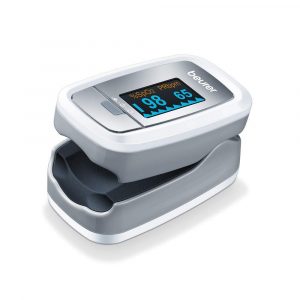
This two-ounce device is described as being able to provide ‘reliable’ pulse oximeter readings for your oxygen levels (SpO2) and heart rate. The best part is that the Beurer PO30 Pulse Oximeter allows checking the readings in 4 graphic display formats which can be a boon to a lot of people as it allows them to adjust the display to their needs. Besides, it has adjustable lighting and brightness too. It is also super easy to use and is simply perfect for use at home and by anyone.
Buying the Beurer PO30 Pulse Oximeter may also prove to be a one-time investment because it is made of high-quality, durable material and also has a ‘low-battery’ indicator as well.
3. Contec

The Contec CMS50D is a clever device. Equipped with Photoelectric Oxyhemoglobin Inspection Technology, it can give you some of the fastest most accurate readings of SpO2 levels ever. Along with the usual great features such as being lightweight, consuming low energy, showing accurate results and so on, the Contec CMS50D is also resistant to external light conditions - that is, reading the results are easy anywhere - whether outside, under indoor lighting or even in darkness.
The Contec CMS50D is popular for measuring SpO2 levels in both, residential as well as professional settings.
4. Zacurate
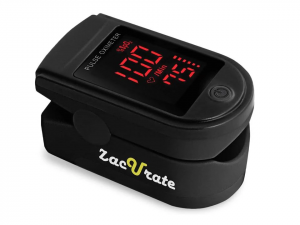
The Zacurate 500DL Pro was specially designed to measure oxygen saturation level for intense sports enthusiasts such as climbers, cyclists, aviators, hikers and so on. With the Zacurate 500DL Pro, you can determine oxygen saturation level in less than 10 seconds. During the pandemic, this device has been found to be useful as a home pulse oximeter as well. Manufactured as per the directions of the FDA and the CE, the Zacurate 500DL Pro can be used for quick, accurate readings of oxygen saturation level.
It comes with a silicon cover to protect it from dirt and scratches and has a 1-year warranty. Besides, thanks to its small size and large, clear display, it becomes a very easy and convenient device to use as a home pulse oximeter. If you are looking for a sophisticated, highly efficient way of monitoring Covid-19 oxygen levels, then give the Zacurate 500DL Pro a try.
5. Masimo MightySat Fingertip
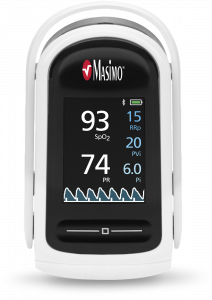
Masimo markets itself as leading pulse oximeter producer thanks to its Signal Extraction Technology® (SET©). In fact, believe it or not, this pulse oximeter is so efficient that Masimo claims that it can provide an accurate measurement of oxygen saturation even when hospital-grade oximeters fail!
Needless to say, this pule oximeter is very advanced and highly specialized medical-grade pulse oximeter. However, if you are looking for only the most accurate home pulse oximeter for your personal use, then the Masimo MightySat Fingertip is definitely a viable option.
This medical-grade pulse oximeter can give you accurate no matter what the lighting or climatic conditions, even when there is movement, and irrespective of any skin pigmentation. Besides, it can also be connected to your smartphone, has a long battery life, and is surprisingly easy to use.
6. Hopkins
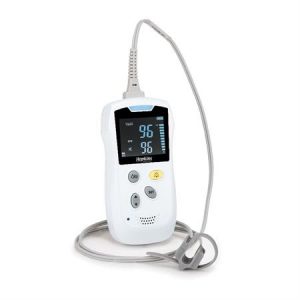
The Hopkins Handheld Pulse Oximeter is a classic, no-nonsense pulse oximeter that can give you pretty accurate readings for your pulse oximeter readings chart. This oxygen saturation monitor is specially used for healthcare in the residential setting. It is especially useful for continuous monitoring of oxygen levels and great for spot checks too.
One unique thing about the Hopkins Handheld Pulse Oximeter is that it comes in three settings for three age groups: neonatal (1-15Kg), pediatric (15-40Kg) and adult (40Kg and above). With this device, you can actually maintain an oximeter reading chart for people of all ages. At a time when assessing Covid-19 oxygen levels of all our loved ones is imperative, this device can be a real boon.
7. Wellue

This has got to be the most unique and easy-to-use pulse oximeter out there. This pulse oximeter can simply be worn on your finger, which for its part will continuously monitor your oxygen levels and alert you with vibration the moment it detects a drop in oxygen levels.
This FDA-backed oxygen level reader can do more than just keep track of oxygen level in Covid - it also monitors heart rate and body index as well. It is a smart medical device with connectivity to phones and computer. The Wellue O2 Ring finds application across a number of health issues ranging from problems such as snoring and sleep apnea to even asthma and pneumonia. Needless to say, today it finds application in monitoring oxygen levels in Covid as well.
The Wellue O2 Ring helps maintain your health data to help you or your doctor to identify health patterns. This can be of great help not just for Covid-related issues, but for many others as well.
8. Atmoko
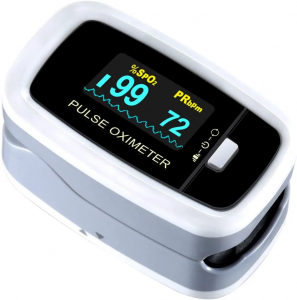
The Atmoko Pulse Oximeter Finger Oximetry is a simple, effective and accurate pulse oximeter. This pulse oximeter can give you results in less than 10 seconds. The neat, clear OED display can show you a number of measurements such as your oxygen levels, pulse rate and bar graph, pulse rate waveform and so on.
The Atmoko Pulse Oximeter Finger Oximetry is another device that is used not just for medical reasons, but also by sportspeople as well. No wonder that the display is rotatable and can be viewed from any direction and has four display options.
This pulse oximeter has a long battery life and is easy to use as well, making a great pulse oximeter for use at home.
9. HealthSense
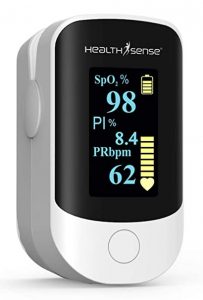
HealthSense is an Indian brand trying to bring tools for healthy living equipped with cutting-edge technology. The HealthSense Accu-Beat FP 910 Fingertip Pulse Oximeter is a sleek oxygen saturation monitor that is easy to use, boasting an ability to display results within 8 seconds. Its four-directional OLED display adds to the easy experience and also displays Perfusion Index, Pulse Rate and Plethysmograph as well.
One of the best things about this pulse oximeter, especially during the Covid-19 pandemic, is that the finger chambers are latex and allergen-free, preventing microbial infections. The HealthSense Accu-Beat FP 910 Fingertip Pulse Oximeter also has a built-in alarm and other sound features and can be operated simply at the click of one button.
Conclusion
A pulse oximeter or finger oxygen sensor is not just a fancy device that only seriously sick people need anymore. Like we said earlier, the rate at which the Covid virus is spreading and mutating, an oximeter can prove to be a real life-saver!
The old saying - “a stitch in time saves nine” has never been truer before than it is today during the Covid-19 pandemic. A lot of deaths and complications have found to arise due to lax attitude and delay in professional medical treatment. Yes, you may not be able to say for sure whether or not you have been infected if you are asymptomatic, and neither is it practical to go and get tested every day. However, that does not mean that you should not do whatever little you can to keep yourself and your loved ones safe.
At the very least, a pulse oximeter can keep you informed of dropping oxygen levels, even if it cannot actually indicate presence of the Covid infection. But hey - even if you are not infected by Covid, you still have learnt that your oxygen leves are low and you can still seek medical care for whatever is causing it. Either way, it is a win-win situation for you and your loved ones - so why take a chance?
Each pulse oximeter we have listed out here is special in its own ways and it all boils down to which features are really relevant to you. Obviously, the more advanced and sophisticated a pulse oximeter device, the more expensive it can get, and that is a call that you have to take.
Please note that it is not necessary that the pulse oximeter you choose from this list was designed for Covid - or even for medical use. Some may be designed to monitor oxygen levels in other situations. So do check if they have a model that is specifically redesigned for use in a medical context. If not, don’t worry - having a medical version of the device is more for our personal satisfaction than for any actual requirement. Either way, you will still get the oxygen-level reading that you need.
If there are is a pulse oximeter out there that you would like to recommend to others and you yourself have a personal experience with, do let us know! Stay safe.

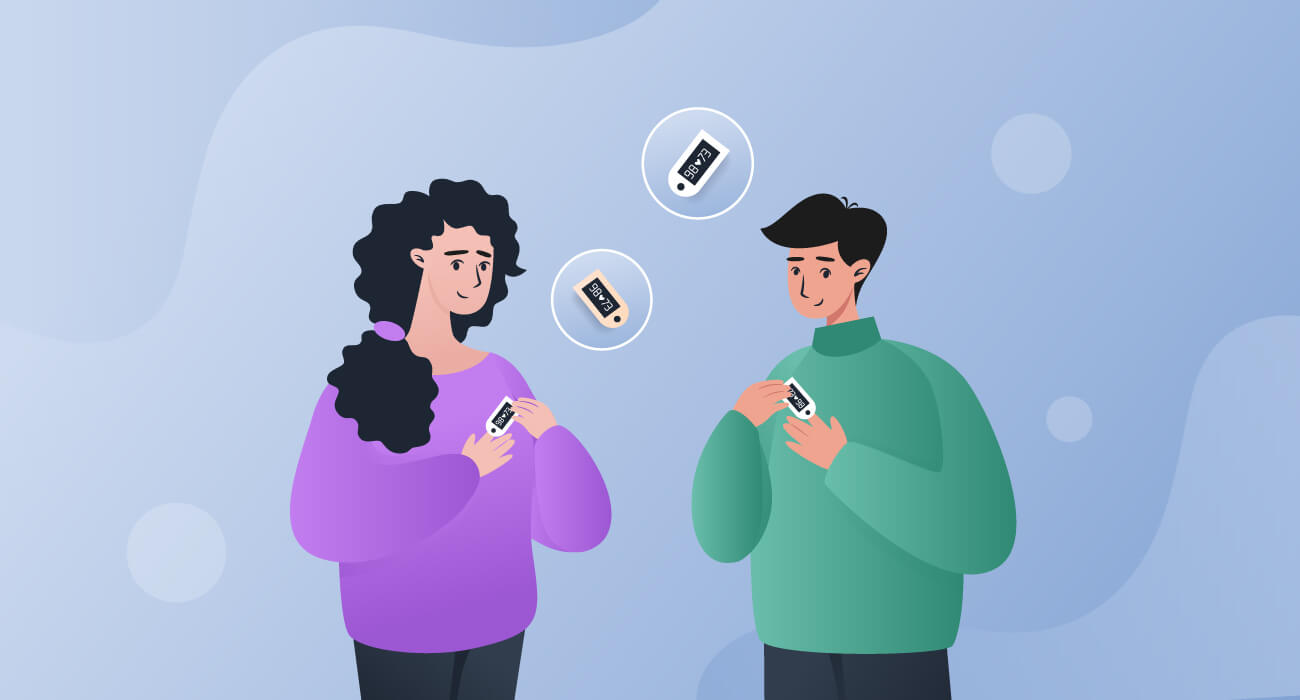

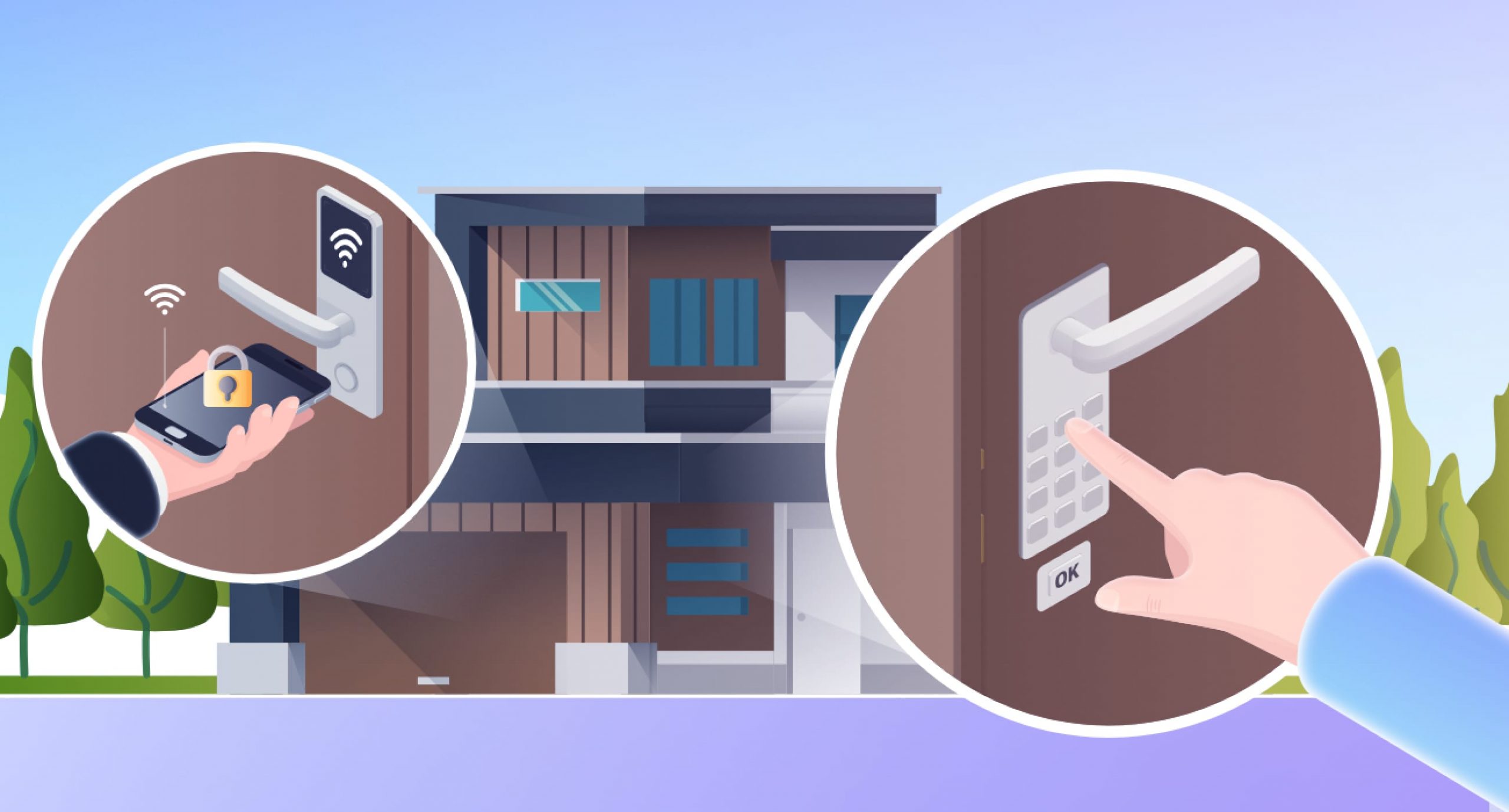










Leave a Reply